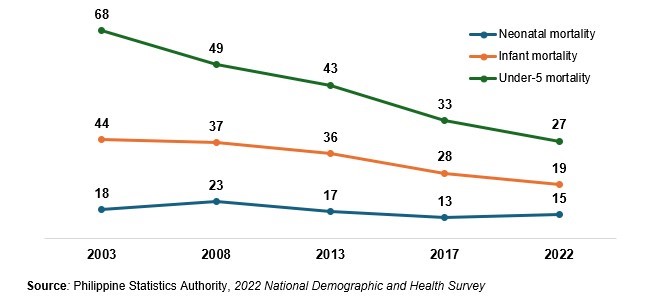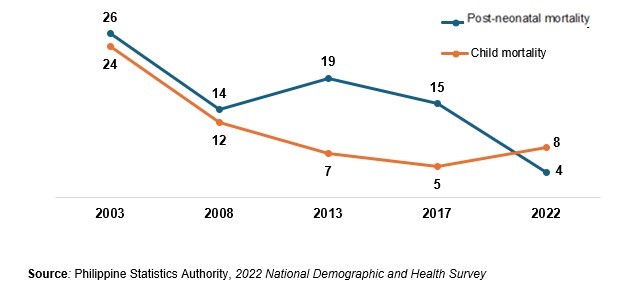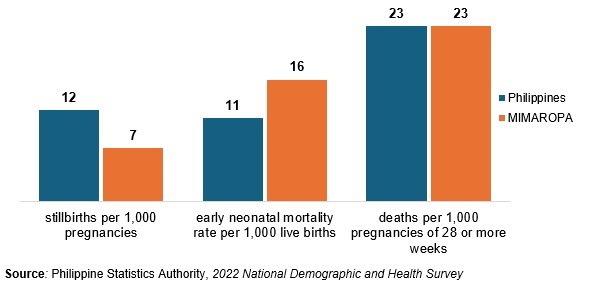Explanatory Note Information on infant and child mortality is relevant to a demographic assessment of a country’s population and is an important indicator of the country’s socioeconomic development and people’s quality of life. It can also help identify children who may be at higher risk of death and lead to strategies to reduce this risk, such as promoting birth spacing. The first month of life is the most vulnerable period for child survival. Children who die within the first 28 days of birth often suffer from conditions and diseases associated with lack of quality care at or immediately after birth and in the first days of life. Promoting newborn survival requires building strong health services, ensuring that every birth is attended by skilled personnel, and making hospital care available for emergencies. It is crucial that early essential newborn care is provided, including immediate and prolonged skin-to-skin contact and early and exclusive breastfeeding, to improve chances of survival and to lay the foundations for a healthy life (WHO 2023). |
Childhood mortality in MIMAROPA region has generally declined over the last two decades
Childhood mortality can be measured according to the survival period of a child from birth, within the first month of life until the age of five. Neonatal mortality is the probability a newborn would die within the first month of life. Infant mortality refers to the probability a newborn would die before reaching exactly one (1) year of age. Post-neonatal mortality refers to the difference between infant and neonatal mortality. Under-five mortality is the probability a newborn would die before reaching exactly five (5) years of age. Child mortality is the probability a newborn would die after first year of age but before reaching exactly fifth year of age.
During the five years immediately preceding the survey, the neonatal mortality rate in MIMAROPA Region was 15 deaths per 1,000 live births which is the same rate with the Philippines. Infant mortality rate in the region was 19 deaths per 1,000 live births and was lower by three deaths per 1,000 live births at the national level. Likewise, in the post-neonatal mortality of the region in 2022, about four deaths per 1,000 live births was recorded. This was three deaths per 1,000 live births lower than the national level. (Figure 1)
In the region, the under-five mortality rate in 2022 was 27 deaths per 1,000 live births which is higher than the country’s rate of 26 deaths per 1,000 live births. Likewise, the child mortality in the region which at eight deaths per 1,000 live births was higher than the national rate by three deaths per 1,000 live births. (Figure 1)
Figure 1. Childhood Mortality Rates, Philippines and MIMAROPA Region: 2022

Figure 2 presents the trends in childhood mortality in MIMAROPA Region, as assessed through previous conduct of the National Demographic and Health Surveys (NDHS). Under-five mortality rates decreased from 68 deaths per 1,000 live births during the five years immediately preceding the 2003 NDHS to 27 deaths per 1,000 live births in 2022. A similar pattern of decline was observed for infant mortality from 44 deaths per 1,000 live births in 2003 to 19 deaths per 1,000 live births in 2022. Neonatal mortality declined from 18 deaths per 1,000 live births in 2003 to 15 deaths per 1,000 live births in 2022.
Figure 2. Trends in Childhood Mortality, MIMAROPA: 2022

Post-neonatal mortality which refers to the difference between infant and neonatal mortality in MIMAROPA Region has generally declined from 26 deaths per 1,000 live births in 2003 to 4 deaths per 1,000 live births in 2022. Child mortality, the other hand declined in 2017 with 5 deaths per 1,000 live births in 2003 from 24 deaths per 1,000 live births in 2003 and increased in 2022 with 8 deaths per 1,000 live births.
Figure 3. Trends in Post-Neonatal and Child Mortality, MIMAROPA: 2022

Perinatal Mortality
Perinatal deaths comprise stillbirths (pregnancy losses occurring after 28 weeks of gestation) and early neonatal deaths (deaths of live births within the first seven days of life). Stillbirth rate is the number of stillbirths per 1,000 pregnancies lasting 28 or more weeks and early neonatal death rate, number of early neonatal deaths per 1,000 live births. Perinatal mortality rate is the number of stillbirths and early neonatal deaths per 1,000 pregnancies lasting 28 or more weeks.
In the 2022 NDHS, MIMAROPA Region recorded two stillbirths, equivalent to a rate of seven stillbirths per 1,000 pregnancies of 28 or more weeks’ duration. The Philippines had a total of 93 stillbirths which corresponds to a rate of 12 stillbirths per 1,000 pregnancies of 28 or more weeks’ duration. (Figure 4)
Figure 4. Perinatal Mortality Rate, Philippines and MIMAROPA Region: 2022

Meanwhile, there were four early neonatal deaths during the five-year period preceding the survey in the region. This corresponds to a rate of 16 early neonatal deaths per 1,000 live births. The region’s early neonatal deaths was higher than the country’s early neonatal death by five cases per 1,000 pregnancies of 28 or more weeks‘ duration. Furthermore, these yield the perinatal mortality rate of 23 deaths per 1,000 pregnancies of 28 or more weeks’ duration in both Philippines and MIMAROPA Region. (Figure 4)

